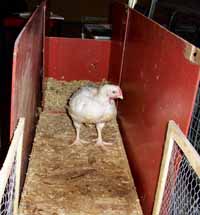Poor gait but not poor welfare

Scientists at the Scottish Agricultural College in Auchincruive have completed research which has found an awkward walking style in chickens does not necessarily indicate the bird is experiencing pain.
The DEFRA funded study, Further development of a method for objective and reliable assessment of broiler leg health under commercial conditions, set out to determine if there was a correlation between birds walking awkwardly and physiological signs of trauma which would show up during dissection.
Birds were tested for their “gait score”, which is a measure of how well or badly they walk, with zero (GS0) being perfect and five (GS5) being very poor. They were also tested using a force plate with a detailed analysis taken on the amount of pressure they put on each foot using load cells.
The research is topical as the Farm Animal Welfare Council has expressed concern that there has been insufficent progress on lameness in broilers since their report in 1992 said the amount of leg problems was unaccaptable.
The European Food Safety Authority also raised concerns about the genetic selection of broiler birds and their welfare status, (Poultry World, September 2010).
The focus of the SAC research was on birds across a range of walking styles (GS1 to GS4). No birds with a gait score of zero or five were observed in the experimental flocks.
“Part of the reason the bird is walking imperfectly may be made up of things you can’t see when you dissect them,” said Dr Victoria Sandilands, research leader at SAC.
“When you have a chicken with very broad breast muscle it is going to make them walk very differently to say, a laying hen. It’s a combination of things, but some pathologies that you see under dissection might be painful, they might not.
“The interesting challenge is that birds can be gait score three for a variety of reasons. You can have 50 gate score three birds and look at them post-mortem and have various different reasons explaining or not explaining why they walk differently.”
In the research Dr Sandilands quotes from a 2008 research paper, which assessed the walking ability of 51,000 birds within 176 commercial UK flocks, finding a “high prevalence of poor locomotion occurred despite culling policies designed to remove severely lame birds from flocks”.
In the latest research, a control flock at the SAC of just under 1100 birds, made up of three different strains of commercial breeds, was assessed from three to six weeks of age for their gait score and force plate measures. Some 338 of the birds were slaughtered at six weeks of age and assessed for leg pathology.
The second group of birds were from commercial flocks made up of the UK standard Ross 308 chicken breed, with birds tested on farm at five weeks for their gait score and 191 birds from a range of scores (GS1 to GS4) then slaughtered.
Out of the birds dissected, 41% had had an abnormality or pathological problem but had a gait score rating of less than three, while 37% of birds had no abnormalities or pathological problems but returned GS rating of three and above.
This suggests there is no obvious link between a bird’s gait and any actual physiological problems.
Dr Sandilands said her team is following up the research with a further study to assess if birds with GS3 ratings experience pain while walking.
“We will do studies with analgesics to see if they change walking style,” Dr Sandilands said.
“Also we will look at animals’ motivation. Are they willing to stand up to get food or will they prefer to sit down where they can’t get food. It’s called a trade-off test and we will use it to make an assessment of the GS3 birds, to try to deterimne if they are in pain.”
The SAC’s research project will be published in January in a paper called “Assessing leg health in chickens using a force plate and gait scoring: how many birds is enough?” in Veterinary Record.
